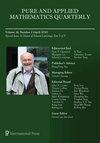Milnor fibre homology complexes
IF 0.8
4区 数学
Q3 MATHEMATICS
引用次数: 0
Abstract
Let $W$ be a finite Coxeter group. We give an algebraic presentation of what we refer to as “the non-crossing algebra”, which is associated to the hyperplane complement of $W$ and to the cohomology of its Milnor fibre. This is used to produce simpler and more general chain (and cochain) complexes which compute the integral homology and cohomology groups of the Milnor fibre $F$ of $W$. In the process we define a new, larger algebra $\tilde{A}$, which seems to be “dual” to the Fomin–Kirillov algebra, and in low ranks is linearly isomorphic to it. There is also a mysterious connection between $\tilde{A}$ and the Orlik–Solomon algebra, in analogy with the fact that the Fomin–Kirillov algebra contains the coinvariant algebra of $W$. This analysis is applied to compute the multiplicities ${\langle \rho, H^k (F, \mathbb{C}) \rangle}_W$ and ${\langle \rho, H^k (M, \mathbb{C}) \rangle}_W$, where $M$ and $F$ are respectively the hyperplane complement and Milnor fibre associated to $W$ and $\rho$ is a representation of $W$.米尔诺纤维同源复合体
让 $W$ 是一个有限考斯特群。我们给出了所谓 "非交叉代数 "的代数表述,它与 $W$ 的超平面补集及其米尔诺纤维的同调相关联。我们用它来生成更简单、更通用的链(和共链)复数,计算 $W$ 的米尔诺纤维 $F$ 的积分同调与同调群。在这个过程中,我们定义了一个新的、更大的代数 $\tilde{A}$,它似乎与弗明-基里洛夫代数是 "对偶 "的,而且在低阶与它线性同构。$\tilde{A}$与奥利克-所罗门代数之间还有一种神秘的联系,这与弗明-基里略夫代数包含$W$的共变代数这一事实相类似。这一分析被应用于计算乘数 ${langle \rho, H^k (F, \mathbb{C}) \rangle}_W$ 和 ${langle \rho, H^k (M, \mathbb{C}) \rangle}_W$ ,其中 $M$ 和 $F$ 分别是与 $W$ 相关的超平面补集和米尔诺纤维,而 $\rho$ 是 $W$ 的表示。
本文章由计算机程序翻译,如有差异,请以英文原文为准。
求助全文
约1分钟内获得全文
求助全文
来源期刊
CiteScore
0.90
自引率
0.00%
发文量
30
审稿时长
>12 weeks
期刊介绍:
Publishes high-quality, original papers on all fields of mathematics. To facilitate fruitful interchanges between mathematicians from different regions and specialties, and to effectively disseminate new breakthroughs in mathematics, the journal welcomes well-written submissions from all significant areas of mathematics. The editors are committed to promoting the highest quality of mathematical scholarship.

 求助内容:
求助内容: 应助结果提醒方式:
应助结果提醒方式:


